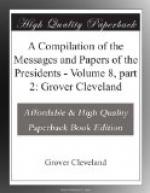It will hardly be contended that in such case this Government should pay twice for the lands. In the appropriation under discussion this principle is in part recognized, for no claim is made by the Choctaws and Chickasaws for the lands allotted to the Cheyennes and Arapahoes. The claim is for unallotted or surplus lands. The case of the Cheyennes and Arapahoes is this: In consideration of other lands the Government gave them a treaty reservation in the Cherokee Outlet, but never perfected it by paying the Cherokees the stipulated price and placing these Indians upon it. The Cheyennes and Arapahoes declined to go upon the strip and located themselves farther south, where they now are. The Government subsequently recognized their right to remain there, and set apart the lands now being allotted to members of that tribe and the lands for which payment is now claimed by the Choctaws and Chickasaws as the Cheyenne and Arapahoe Reservation. I think the United States must be held to have assented to the substitution of these lands for the treaty lands in the Cherokee Strip, and that being true, when the reservation is broken up, as now, by allotments, it would seem that the Cheyennes and Arapahoes were entitled to be compensated for these surplus lands. In fact, a commission which has been dealing with the tribes in the Indian Territory has concluded an arrangement with them by which the Government pays $1,500,000 for these surplus lands and for the release of any claim to the Cherokee Strip, so that in fact in this agreement with the Cheyennes and Arapahoes the Government has paid for the lands for which payment is now claimed by the Choctaws and Chickasaws.
It should not be forgotten also that the allotment to the Cheyennes and Arapahoes is still incomplete. The method of calculation which resulted in stating the claim of the Choctaws and Chickasaws at $2,991,450 is explained by a letter of Mr. J.S. Standley, one of the Choctaw delegates, dated April 6, 1891. The agent for the Cheyennes and Arapahoes wrote Mr. Standley that there were 600 Indians residing upon the lands south of the Canadian River, and who it was supposed would take allotments there, and upon this statement the legislation was based. Now it must be borne in mind that the Cheyennes and Arapahoes have the right to locate anywhere within their reservation, and that instead of 600 double that number might have taken their allotments south of the Canadian River




